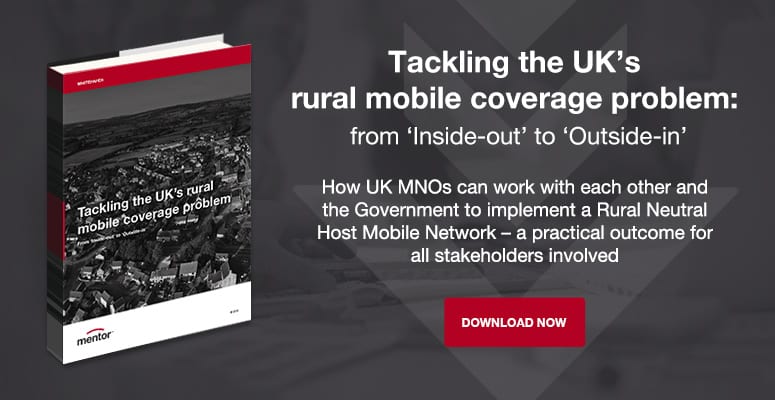UK fibre rollout strategy – time to release the brakes?
It’s about time rural got the mobile coverage it deserves
We’ve been working on how to crack the twin challenges of 4G densification and 5G mobilisation in the hearts of our biggest cities – where mobile networks are the most profitable.
But we’ve recently looked at the other end of the demographic spectrum – the extremely poorly served rural fringe. Operator profit in these areas is somewhere between zero and nothing.
Our friends in the countryside don’t want our sympathy, they just want decent Broadband and Mobile service.
Over the years, there have been many Government attempts to fix this problem. BT won almost all of the county-based projects to extend broadband coverage from BT’s own claimed limits of commercial viability.
On mobile, spectrum auctions have carried rollout obligations – the latest being one for 700MHz.
Coverage has improved for some but the definition of coverage is getting more demanding.
A phone call with a one-bar signal – standing on a wheelie bin at the end of your garden – doesn’t cut it for todays’ smartphone users. What they need is decent 4G coverage and, as 5G rolls out, plenty of that too.
Spectrum – a magic bullet?
Ofcom has been actively “tilting” at the rural mobile coverage problem with the recent consultations on the 700MHz and 3.4-3.8GHz spectrum. They estimate 66% of the UK’s landmass has good 4G from all 4 operators, while 9% has none at all.
Ofcom proposes attaching rural coverage obligations to this 700MHz spectrum.
According to Marc Allera:
This is good in principle, but won’t overcome the barriers that make it so difficult to expand coverage, or do enough to achieve the 95pc coverage target.
The Government’s Future Telecoms Infrastructure Review (FTIR) provides a context for this initiative. The spectrum on offer includes 3.4 – 3.8GHz, (this is really urban spectrum), and 700MHz, (ideal for rural coverage).
All 4 mobile operators would bite your hand off to get 700MHz spectrum.
But will this spectrum, in new ownership, reduce the 9% of unserved rural areas?
What if the operator with the poorest coverage wins it? Won’t that just increase the 66% number – and leave the 9% untouched?
We understand Ofcom’s approach – but it has fallen well short of solving the rural issue, so far.
We need a different approach to avoid continuing exasperation in the rural fringe.
Let’s stay objective
Our approach goes something like this.
Discounted spectrum is not going to make this an economic prospect for any operator. Just accept the problem needs subsidy and design a solution that gives us the ‘best’ cost.
There are nearly 40k rural premises that have neither mobile nor broadband coverage, according to Ofcom, so we need a solution that delivers both.
The Government has set aside £200m for a Rural Gigabit Connectivity (RGC) Programme to drive and encourage independent fibre investment in rural areas – including using public buildings as local fibre hubs.
This new fibre must support Mobile masts and Full Fibre broadband – so make ‘Mobile-Centric Fibre’ work for rural – and exploit our old friend DPA as a key enabler.
When you think about it, if you had a choice of using mobile or fixed technology, you’d use a mobile. Anyone in the area could then use the service – not just the lucky residents in their living rooms.
We think the 700MHz spectrum could provide circa 70Mbps per sector on the downlink, using the latest 4G technology.
But if most of the usage is indoors, capacity plummets, as the base station has to devote more resources to compensate for poor signals.
5G is not going to dramatically increase capacity – since its innovations are focussed on Urban.
The bottom line is there’s not enough spectrum.
Explore our 5G services at Mentor Europe.
From “Inside-Out” to “Outside-In”
We think the solution is to build an Active Neutral Host ‘Mobile-Centric’ Network, designed to deliver a knockout blow to the 9% unserved areas. But, emphatically not, trying to stretch the existing national networks to cover the 9%, piecemeal.
An ‘Outside-In’ approach.
- Reserve 700MHz spectrum for an ‘Outside-In’ rural Mobile network.
- Adding 800MHz and 900MHz mobile spectrum to 700MHz would give us c140Mbps per sector downlink capacity. The spectrum that is plainly unused since coverage is some way short of 100%.
- Build an Active Neutral Host Mobile Network – and either encourage or force the Mobile operators to roam onto it – perhaps as a condition of buying the rest of the 700MHz and/or the 3.4-3.8GHz 5G spectrum.
- Engage at least one fixed ISP to deliver a fixed wireless broadband service for those customers whose best option is to use mobile technology for their broadband. And support it with some rooftop technology to bolster spectral efficiency.
What’s the key message here?
Let’s just focus on the main problem – and crush it.
‘Inside-Out’ has been hugely successful for UK Mobile and Broadband – but it won’t solve the misery of rural telecoms deprivation.
Only ‘Outside-In’ will do that.
Our fascination with the rural telecoms issue has been instructive. Mentor’s ‘Mobile-Centric Fibre’ Approach – designed for dense urban – has surprised us by demonstrating a clear relevance at the opposite end of the demographic spectrum.
Taking everything into account, it’s hard not to conclude that the best chance of achieving mobile-parity between the cities and rural areas is to build an Active Neutral Host ‘Mobile Centric’ Network – from the ‘Outside-In’.
Anyone up for taking advantage of this ground-breaking opportunity in the countryside?


